Abstract
A macular-sparing superior altitudinal hemianopia with no visuo-psychic disturbance, except impaired visual learning, was associated with bilateral ischaemic necrosis of the lingual gyrus and only partial involvement of the fusiform gyrus on the left side. It is suggested that bilateral destruction of the lingual gyrus alone is not sufficient to affect complex visual processing. The fusiform gyrus probably has a critical role in colour integration, visuo-spatial processing, facial recognition and corresponding visual imagery. Involvement of the occipitotemporal projection system deep to the lingual gyri probably explained visual memory dysfunction, by a visuo-limbic disconnection. Impaired verbal memory may have been due to posterior involvement of the parahippocampal gyrus and underlying white matter, which may have disconnected the intact speech areas from the left medial temporal structures.
Full text
PDF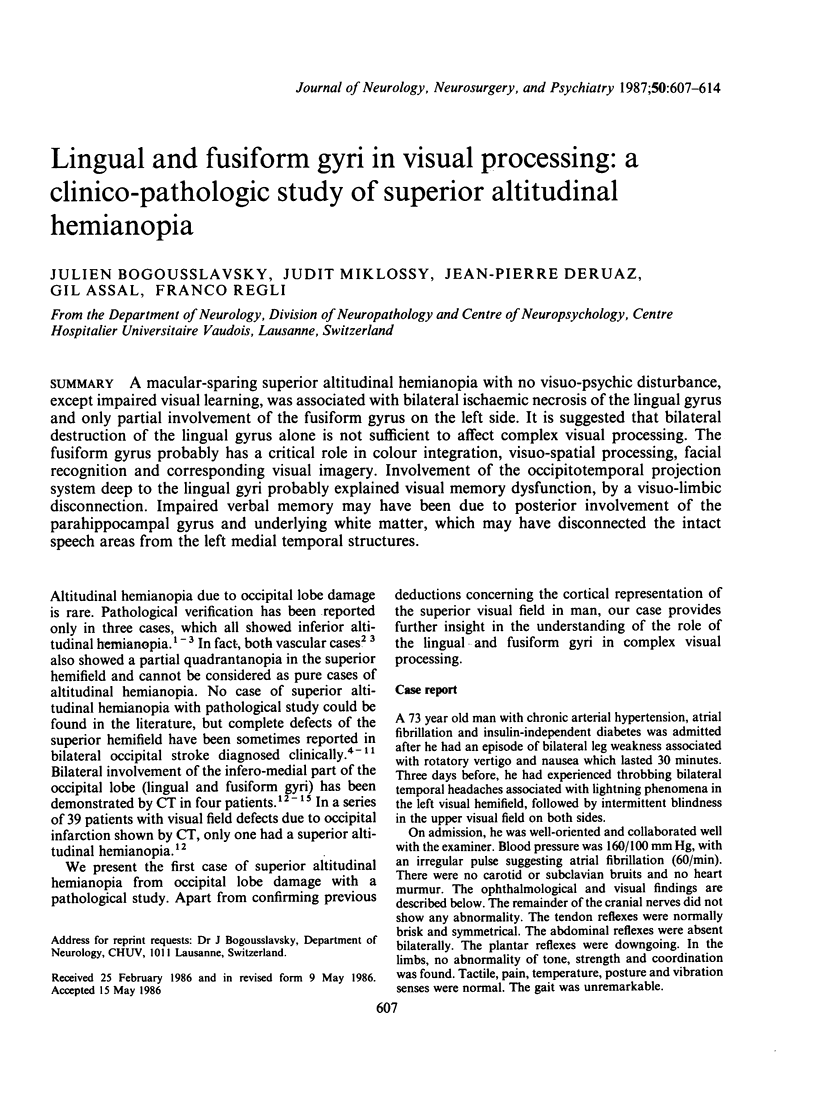
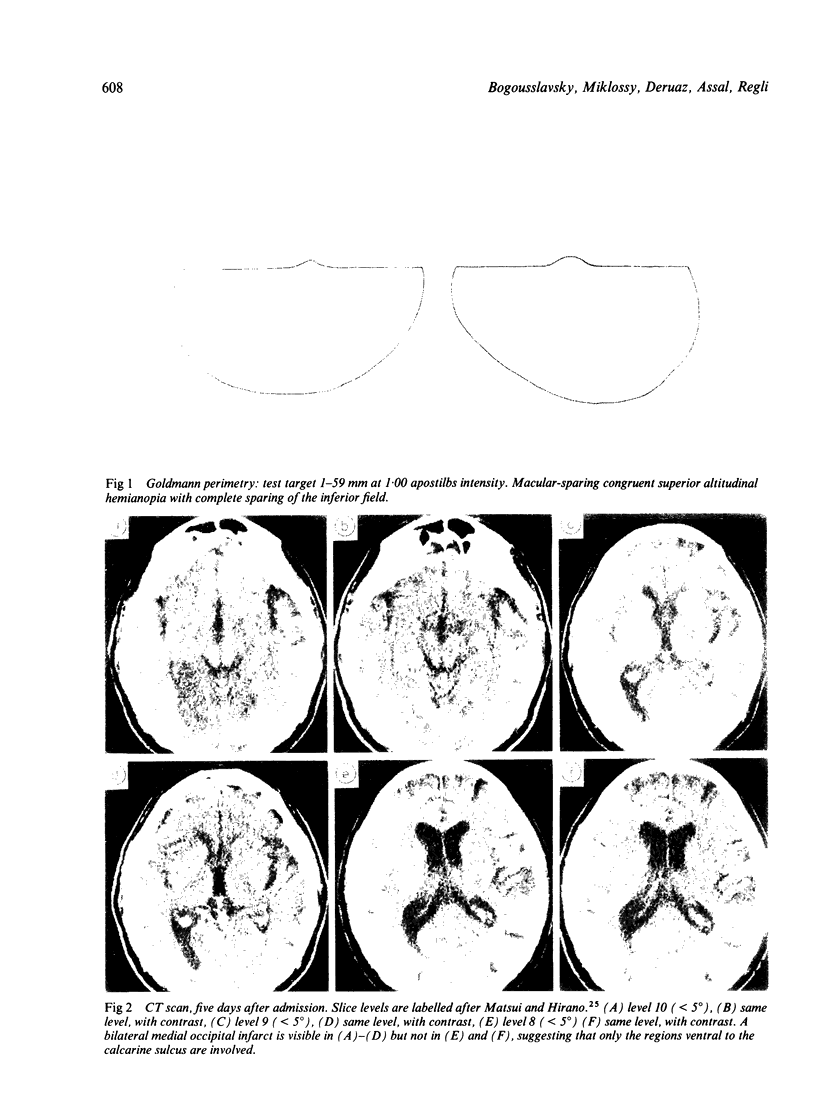

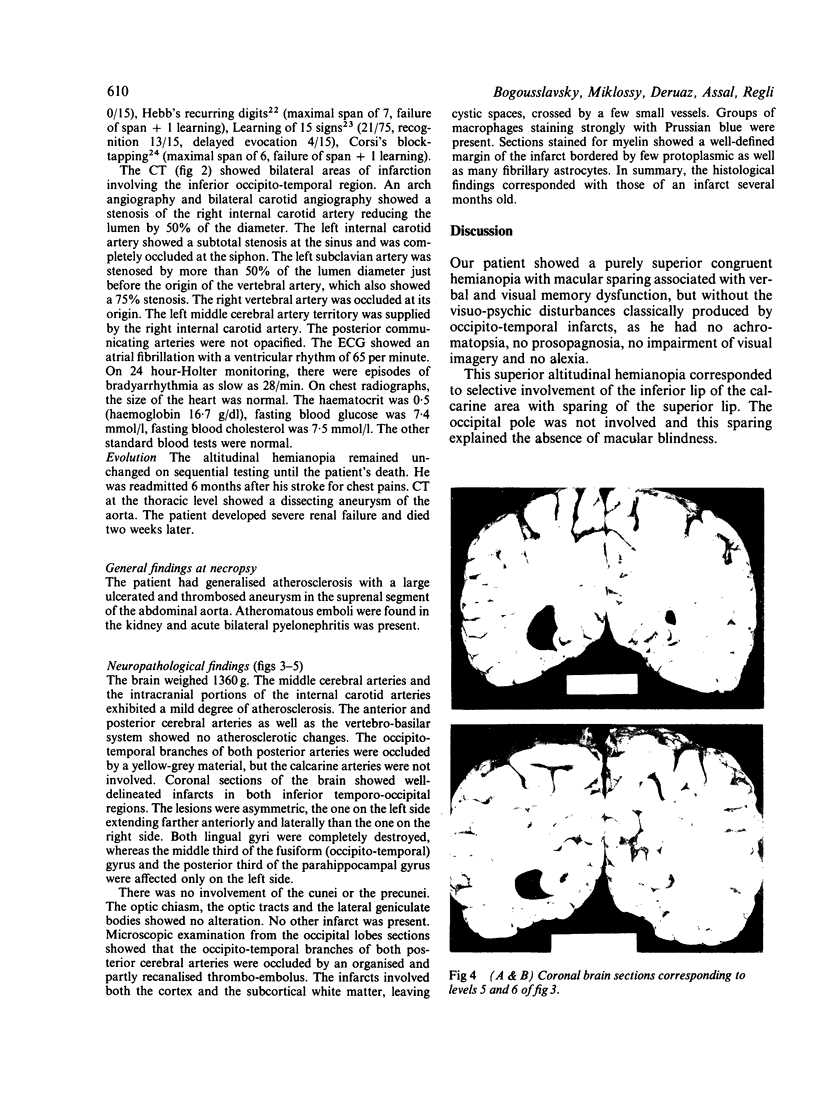
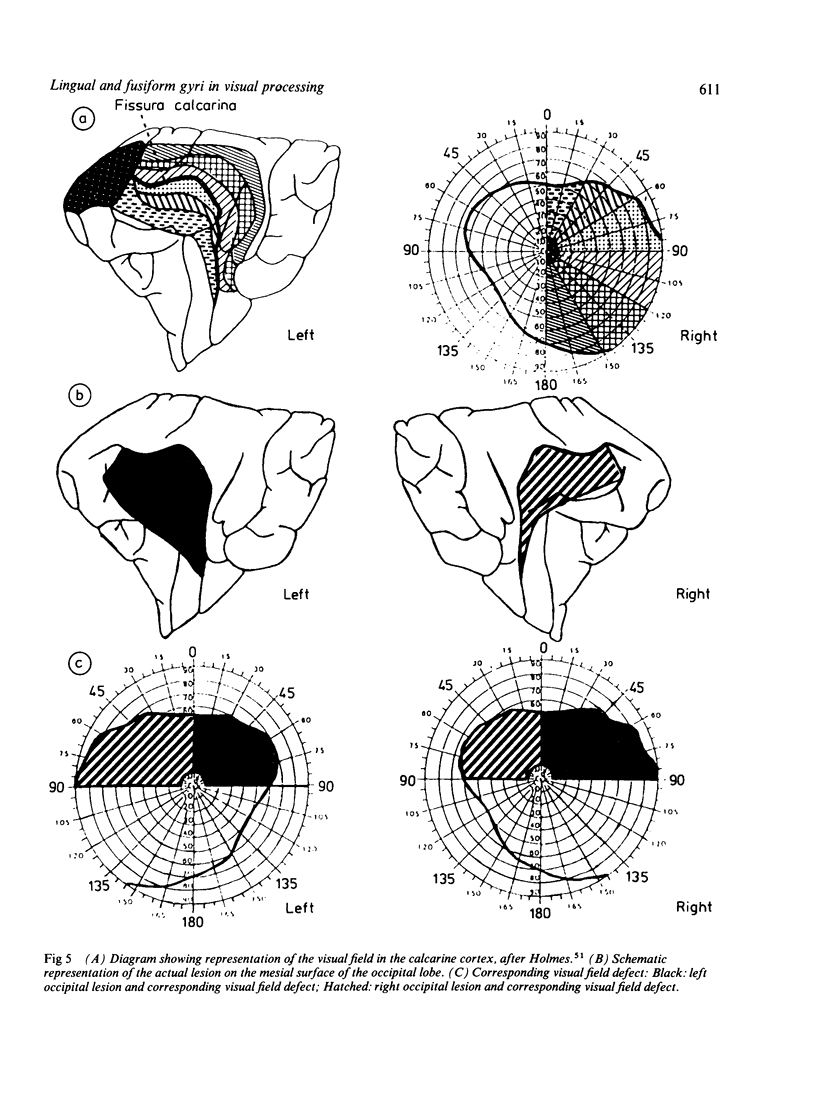
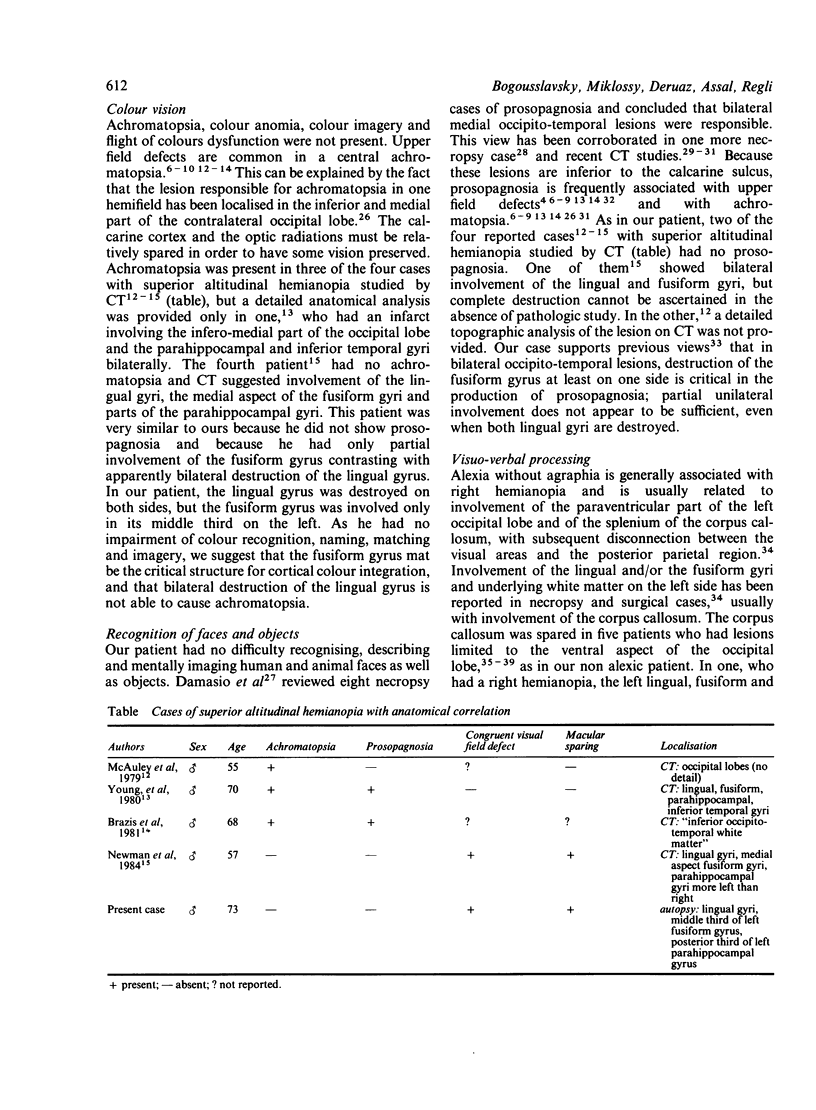
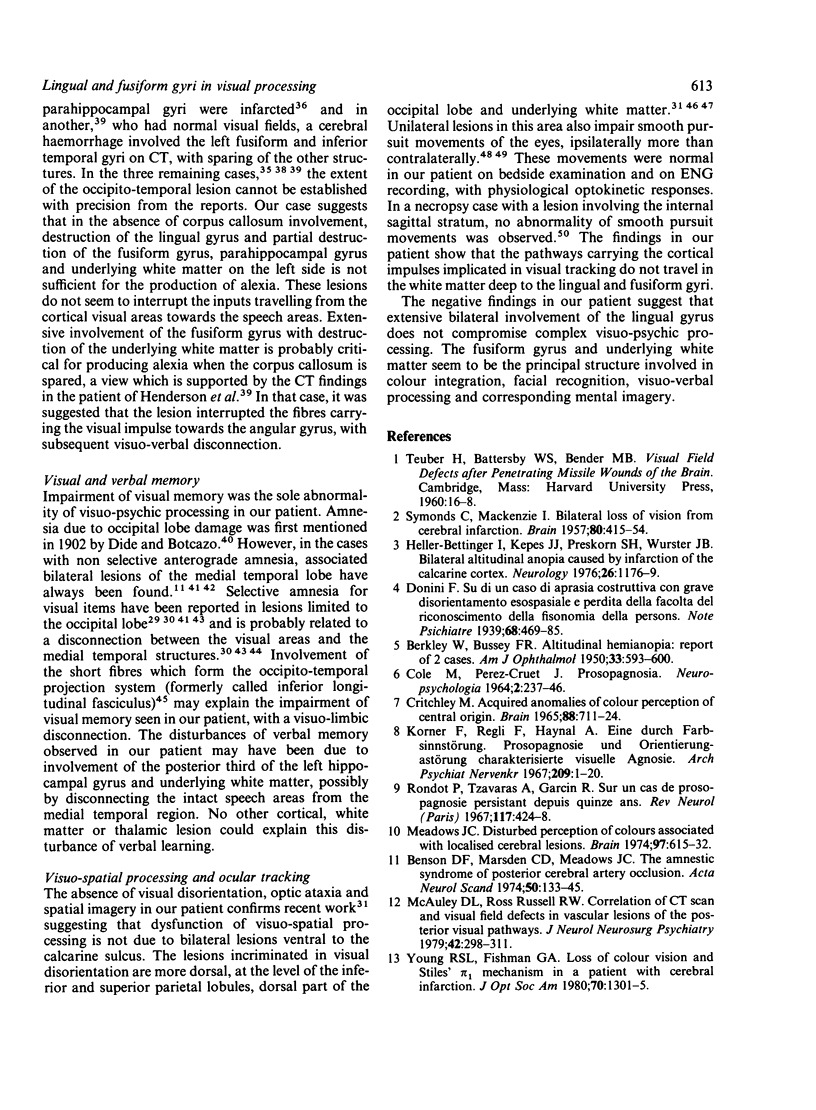

Images in this article
Selected References
These references are in PubMed. This may not be the complete list of references from this article.
- Ajax E. T. Dyslexia without agraphia. Prognostic considerations. Arch Neurol. 1967 Dec;17(6):645–652. doi: 10.1001/archneur.1967.00470300087014. [DOI] [PubMed] [Google Scholar]
- Assal G., Favre C., Anderes J. P. Non-reconnaissance d'animaux familiers chez un paysan. Zoo-agnosie ou prosopagnosie pour les animaux. Rev Neurol (Paris) 1984;140(10):580–584. [PubMed] [Google Scholar]
- Baloh R. W., Yee R. D., Honrubia V. Optokinetic nystagmus and parietal lobe lesions. Ann Neurol. 1980 Mar;7(3):269–276. doi: 10.1002/ana.410070311. [DOI] [PubMed] [Google Scholar]
- Benson D. F., Marsden C. D., Meadows J. C. The amnesic syndrome of posterior cerebral artery occlusion. Acta Neurol Scand. 1974;50(2):133–145. doi: 10.1111/j.1600-0404.1974.tb02767.x. [DOI] [PubMed] [Google Scholar]
- Bogousslavsky J., Regli F. Pursuit gaze defects in acute and chronic unilateral parieto-occipital lesions. Eur Neurol. 1986;25(1):10–18. doi: 10.1159/000115980. [DOI] [PubMed] [Google Scholar]
- Boudin G., Barbizet J., Derouesné C., van Amerongen P. Cécité corticale ET PROBL-EME DES "amnésies occipitales". Rev Neurol (Paris) 1967 Jan;116(1):89–97. [PubMed] [Google Scholar]
- Brazis P. W., Biller J., Fine M. Central achromatopsia. Neurology. 1981 Jul;31(7):920–921. doi: 10.1212/wnl.31.7.920. [DOI] [PubMed] [Google Scholar]
- Brindley G. S., Janota I. Observations on cortical blindness and on vascular lesions that cause loss of recent memory. J Neurol Neurosurg Psychiatry. 1975 May;38(5):459–464. doi: 10.1136/jnnp.38.5.459. [DOI] [PMC free article] [PubMed] [Google Scholar]
- Cohn R., Neumann M. A., Wood D. H. Prosopagnosia: a clinicopathological study. Ann Neurol. 1977 Feb;1(2):177–182. doi: 10.1002/ana.410010213. [DOI] [PubMed] [Google Scholar]
- Critchley M. Acquired anomalies of colour perception of central origin. Brain. 1965 Nov;88(4):711–724. doi: 10.1093/brain/88.4.711. [DOI] [PubMed] [Google Scholar]
- Damasio A. R., Damasio H. The anatomic basis of pure alexia. Neurology. 1983 Dec;33(12):1573–1583. doi: 10.1212/wnl.33.12.1573. [DOI] [PubMed] [Google Scholar]
- Damasio A. R., Damasio H., Van Hoesen G. W. Prosopagnosia: anatomic basis and behavioral mechanisms. Neurology. 1982 Apr;32(4):331–341. doi: 10.1212/wnl.32.4.331. [DOI] [PubMed] [Google Scholar]
- Damasio A., Yamada T., Damasio H., Corbett J., McKee J. Central achromatopsia: behavioral, anatomic, and physiologic aspects. Neurology. 1980 Oct;30(10):1064–1071. doi: 10.1212/wnl.30.10.1064. [DOI] [PubMed] [Google Scholar]
- Girotti F., Milanese C., Casazza M., Allegranza A., Corridori F., Avanzini G. Oculomotor disturbances in Balint's syndrome: anatomoclinical findings and electrooculographic analysis in a case. Cortex. 1982 Dec;18(4):603–614. doi: 10.1016/s0010-9452(82)80057-9. [DOI] [PubMed] [Google Scholar]
- Gomori A. J., Hawryluk G. A. Visual agnosia without alexia. Neurology. 1984 Jul;34(7):947–950. doi: 10.1212/wnl.34.7.947. [DOI] [PubMed] [Google Scholar]
- Greenblatt S. H. Alexia without agraphia or hemianopsia. Anatomical analysis of an autopsied case. Brain. 1973 Jun;96(2):307–316. doi: 10.1093/brain/96.2.307. [DOI] [PubMed] [Google Scholar]
- Heller-Bettinger I., Kepes J. J., Preskorn S. H., Wurster J. B. Bilateral altitudinal anopia caused by infarction of the calcarine cortex. Neurology. 1976 Dec;26(12):1176–1179. doi: 10.1212/wnl.26.12.1176. [DOI] [PubMed] [Google Scholar]
- Henderson V. W., Friedman R. B., Teng E. L., Weiner J. M. Left hemisphere pathways in reading: inferences from pure alexia without hemianopia. Neurology. 1985 Jul;35(7):962–968. doi: 10.1212/wnl.35.7.962. [DOI] [PubMed] [Google Scholar]
- Holmes G. DISTURBANCES OF VISION BY CEREBRAL LESIONS. Br J Ophthalmol. 1918 Jul;2(7):353–384. doi: 10.1136/bjo.2.7.353. [DOI] [PMC free article] [PubMed] [Google Scholar]
- Körner F., Regli F., Haynal A. Eine durch Farbsinnstörung, Prosopagnosie und Orientierungsstörung charakterisierte visuelle Agnosie. Arch Psychiatr Nervenkr (1970) 1967;209(1):1–20. [PubMed] [Google Scholar]
- Levine D. N., Warach J., Farah M. Two visual systems in mental imagery: dissociation of "what" and "where" in imagery disorders due to bilateral posterior cerebral lesions. Neurology. 1985 Jul;35(7):1010–1018. doi: 10.1212/wnl.35.7.1010. [DOI] [PubMed] [Google Scholar]
- Masure M. C., Tzavaras A. Perception de figures entrecroisées par des sujets atteints de lesions corticales unilaterales. Neuropsychologia. 1976;14(3):371–374. doi: 10.1016/0028-3932(76)90031-2. [DOI] [PubMed] [Google Scholar]
- McAuley D. L., Russell R. W. Correlation of CAT scan and visual field defects in vascular lesions of the posterior visual pathways. J Neurol Neurosurg Psychiatry. 1979 Apr;42(4):298–311. doi: 10.1136/jnnp.42.4.298. [DOI] [PMC free article] [PubMed] [Google Scholar]
- Meadows J. C. Disturbed perception of colours associated with localized cerebral lesions. Brain. 1974 Dec;97(4):615–632. doi: 10.1093/brain/97.1.615. [DOI] [PubMed] [Google Scholar]
- Meadows J. C. The anatomical basis of prosopagnosia. J Neurol Neurosurg Psychiatry. 1974 May;37(5):489–501. doi: 10.1136/jnnp.37.5.489. [DOI] [PMC free article] [PubMed] [Google Scholar]
- Mohr J. P., Leicester J., Stoddard L. T., Sidman M. Right hemianopia with memory and color deficits in circumscribed left posterior cerebral artery territory infarction. Neurology. 1971 Nov;21(11):1104–1113. doi: 10.1212/wnl.21.11.1104. [DOI] [PubMed] [Google Scholar]
- Montero J., Peña J., Genis D., Rubio F., Peres-Serra J., Barraquer-Bordas L. Balint's syndrome. Report of four cases with watershed parieto-occipital lesions from vertebrobasilar ischemia or systemic hypotension. Acta Neurol Belg. 1982 Sep-Oct;82(5):270–280. [PubMed] [Google Scholar]
- Nardelli E., Buonanno F., Coccia G., Fiaschi A., Terzian H., Rizzuto N. Prosopagnosia. Report of four cases. Eur Neurol. 1982;21(5):289–297. doi: 10.1159/000115494. [DOI] [PubMed] [Google Scholar]
- Newman R. P., Kinkel W. R., Jacobs L. Altitudinal hemianopia caused by occipital infarctions. Clinical and computerized tomographic correlations. Arch Neurol. 1984 Apr;41(4):413–418. doi: 10.1001/archneur.1984.04050160075019. [DOI] [PubMed] [Google Scholar]
- Ross E. D. Sensory-specific and fractional disorders of recent memory in man. I. Isolated loss of visual recent memory. Arch Neurol. 1980 Apr;37(4):193–200. doi: 10.1001/archneur.1980.00500530031001. [DOI] [PubMed] [Google Scholar]
- SYMONDS C., MACKENZIE I. Bilateral loss of vision from cerebral infarction. Brain. 1957 Dec;80(4):415–455. doi: 10.1093/brain/80.4.415. [DOI] [PubMed] [Google Scholar]
- Sharpe J. A., Deck J. H. Destruction of the internal sagittal stratum and normal smooth pursuit. Ann Neurol. 1978 Nov;4(5):473–476. doi: 10.1002/ana.410040517. [DOI] [PubMed] [Google Scholar]
- Tusa R. J., Ungerleider L. G. The inferior longitudinal fasciculus: a reexamination in humans and monkeys. Ann Neurol. 1985 Nov;18(5):583–591. doi: 10.1002/ana.410180512. [DOI] [PubMed] [Google Scholar]
- Vincent F. M., Sadowsky C. H., Saunders R. L., Reeves A. G. Alexia without agraphia, hemianopia, or color-naming defect: a disconnection syndrome. Neurology. 1977 Jul;27(7):689–691. doi: 10.1212/wnl.27.7.689. [DOI] [PubMed] [Google Scholar]
- Warrington E. K. Neuropsychological evidence for multiple memory systems. Ciba Found Symp. 1979;(69):153–166. doi: 10.1002/9780470720523.ch9. [DOI] [PubMed] [Google Scholar]
- Young R. S., Fishman G. A. Loss of color vision and Stiles' II1 mechanism in a patient with cerebral infarction. J Opt Soc Am. 1980 Nov;70(11):1301–1305. doi: 10.1364/josa.70.001301. [DOI] [PubMed] [Google Scholar]







